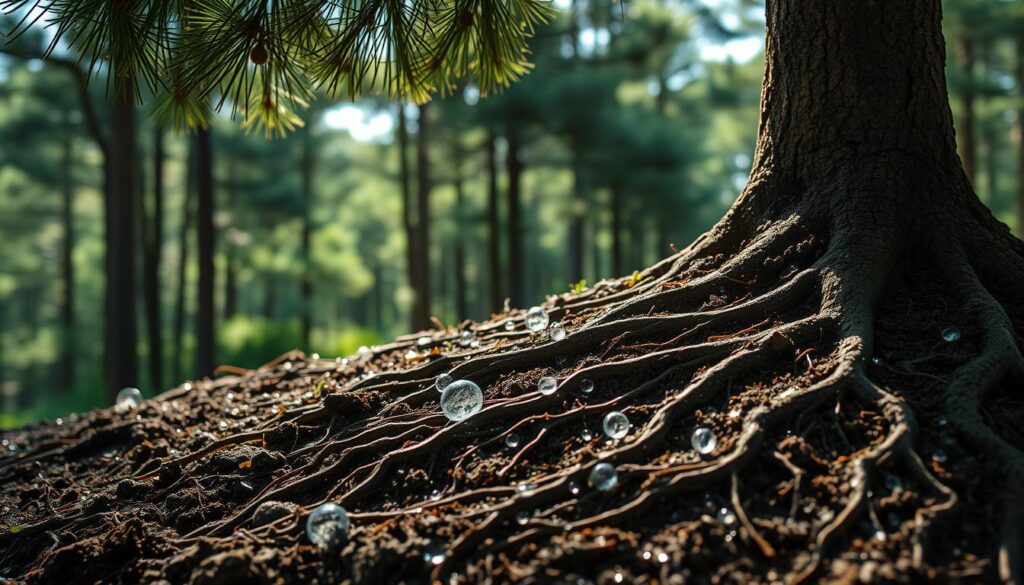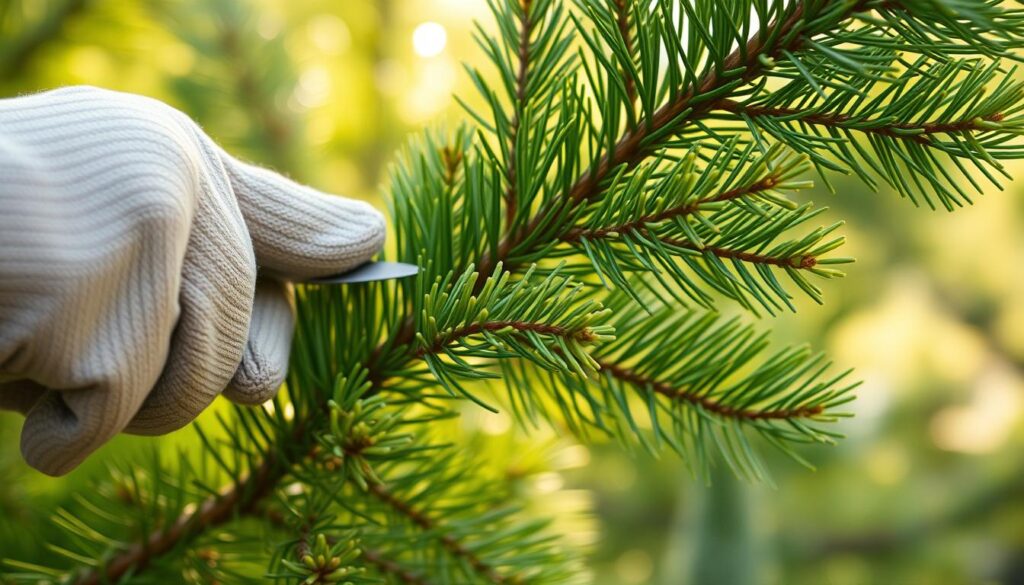I still remember the first small tree I brought home — a scrawny Norfolk Island that made me learn patience fast. That plant taught me how much a single season of attention can change a tree’s future.
Understanding the difference between true pines and pine lookalikes is the first step. Norfolk Island types need bright, indirect light and indoor humidity, while many landscape pines want full sun and quick-draining soil.
Good sites and proper species selection set trees up for success across the year. From planting and drainage tests to pruning with reduction cuts, this guide covers choices that protect roots and preserve natural form.
Expect notes on propagation, seasonal watering, and how candle behavior in certain pines affects shaping. Watch for pests like scale and spider mites, and remember: prevention beats repair when rooting problems start.
Key Takeaways
- Know whether you have a true pine or a lookalike before choosing site and soil.
- Match species to your climate; Norfolk Island is best indoors outside USDA 9–11.
- Prioritize excellent drainage, deep infrequent watering, and avoid shearing.
- Use reduction cuts to maintain structure and respect natural growth habits.
- Plan propagation and major moves in fall or early spring for best results.
- Inspect needles, cones, and bark to guide timely interventions.
What Pine Care Means Today: Set your trees up for year-round health
“A simple, year-round routine makes the difference between a struggling tree and one that thrives.”
Modern care is proactive and seasonal. Prioritize full sun (most need 8+ hours), excellent drainage, and deep, infrequent watering to build drought tolerance.
Planting during dormancy—fall or early spring—gives roots a calm window to establish. This reduces stress from summer heat and improves survival.
Note exceptions: some cultivars like Japanese white and Swiss prefer morning sun and afternoon protection. The Norfolk Island plant is different—bright, indirect light and indoor humidity matter more than full sun.
Use reduction cuts for structure and avoid shearing, which hollows the canopy. Watch for pests and address problems early; most pines stay tough when sun, soil, and drainage are right.
“Consistent routines beat reactive fixes when trouble appears.”
Plan fertilization and irrigation around growth phases, especially the spring push. A steady, year round approach delivers the healthiest trees.
Identify your pine before you start
Start by learning to read the needles, cones, and bark of your tree — identification guides every action.
True pines vs. lookalikes and the Norfolk Island exception
True members of Pinus hold needles in fascicles of 2–5. Firs, spruces, cedars, hemlocks, and junipers do not.
Spot fascicles first and you’ll sort most outdoor species quickly. Reserve the Norfolk Island araucaria as an indoor plant: it needs bright indirect light and humidity and is not a true pine for landscape use.
White, red, and yellow groups: quick ID tips
White pine often shows five-needle bundles, bluish needles, longer cones, and smoother gray bark. Red pines usually have two-needle bundles, yellow-green needles, and reddish bark with denser crowns.
Yellow pines vary; bark tends brown to orange. Combine needle count, cone shape, and bark for a confident ID.
Two-flush vs. one-flush: candles and pruning
Two-flush species (for example Japanese black and Japanese red) can be decandled to shorten internodes. One-flush types like japanese white, Scots, ponderosa, and mugo should not be decandled; instead, select or shorten candles at the right time.
“Identification is the first step to sensible watering, feeding, and pruning.”
| Feature | White Group | Red Group | Yellow Group |
|---|---|---|---|
| Needles per bundle | 5 | 2 | Varies (2–3) |
| Bark color | Gray, smoother | Reddish | Brown to orange |
| Cone length | Longer | Shorter | Variable |
Choose the right pine species for your USDA zone and site
Start by matching climate and soil to species before planting.
Map regional fits to local conditions. In the Northeast and Upper Midwest, eastern white (Pinus strobus), red, and cold-hardy mountain pine (mugo) handle deep freezes and hard winters well. They prefer well-drained soils and full sun.
Northeast & Upper Midwest
Eastern white thrives in usda zones 3–8 but dislikes heavy clay and urban pollutants. Red pines work across similar zones; mugo stays compact for tight sites.
South & Southeast
Loblolly, slash, shortleaf, and longleaf tolerate heat, humidity, and occasional flooding. Loblolly adapts to sandy or clay soils and gives fast screening.
West & High Elevation
Ponderosa, lodgepole, shore, limber, and japanese white suit intense sun and wide temperature swings. Some western cultivars prefer morning sun and shelter from afternoon heat.
- Verify usda zones and local minimum temperatures before buying.
- Factor wind exposure, soil texture, and drainage into siting decisions.
- When collecting seed, choose local sources for better adaptation.
| Region | Top Picks | Soil/Site Notes | Usda Zones (typ.) |
|---|---|---|---|
| Northeast/Upper Midwest | Eastern white, red pine, mugo | Well-drained, avoid heavy clay | 3–8 |
| South/Southeast | Loblolly, slash, shortleaf, longleaf | Tolerates heat, humid sites; some flooding | 6–9 (varies) |
| West/High Elev. | Ponderosa, lodgepole, shore, limber, japanese white | Sunny, well-drained, exposed sites | 2–7 (varies) |
“Choose species that match your zone and site; they need less rescue later.”
Sun, temperatures, and soil conditions that pines need
A tree’s health often starts with two things: hours of sun and soil that actually drains.
Most landscape pines need full sun—about 8 hours of direct light daily—to stay compact and vigorous. In hot sites, moderate afternoon shade helps sensitive cultivars avoid needle scorch while still meeting light needs.
When morning sun or indirect light is better
Some eastern white and selected Japanese or Swiss cultivars do best with strong morning sun and shelter in the afternoon.
The Norfolk Island pine is an indoor exception: it prefers bright, indirect light and higher humidity to thrive in containers or frost-free areas.
Drainage first: soil texture and raised sites
Prioritize drainage before feeding. Sandy, slightly acidic mixes let moisture move and keep roots healthy.
Avoid heavy clay that holds water and invites root rot. On marginal ground, plant on raised mounds or slopes to protect the stem base.
- Aim for full sun exposure for outdoor trees where possible.
- Use well-draining mixes with sand or perlite in containers.
- Match species to local temperatures, reflected heat, and wind exposure.
- Expect longer needles grow in shade; plan pruning accordingly.
“Good light and quick-draining soil protect roots and reduce disease risk.”
Planting pines the right way for strong roots
A solid planting routine builds stronger roots and reduces transplant shock.
When to plant: Target fall or early spring for best results. Transplant while trees are dormant to cut stress and help establishment.
Step-by-step planting basics
Dig a hole roughly twice the width of the rootball and no deeper than its height. A broad, shallow hole encourages lateral roots to explore native soil.
Perform a drainage test: fill the hole with a foot of water and check it drains within 12 hours. If it holds, pick a new site or raise the planting area.
- Set the root collar at or slightly above final grade; avoid burying the stem base.
- Loosen circling roots on container stock and cut a few vertical slices to redirect growth outward.
- Backfill with native soil to prevent a bathtub effect; water thoroughly to settle soil.
- Mulch 2–3 inches deep, keeping material off the trunk. Stake only when necessary and remove supports after one season.
“Keep soil moist but not saturated through the first growing season to help new roots spread.”
| Task | Detail | Why it matters |
|---|---|---|
| Timing | Fall or early spring | Lower stress, better root growth |
| Drainage test | Drains within 12 hours | Avoids root rot and poor establishment |
| Hole size & depth | Twice width, shallow depth | Encourages lateral roots |
Water and moisture management: deep drinks, not soggy roots
Deep-soaking routines build strong roots faster than daily surface sprays. New transplants need slow, thorough watering so moisture reaches the full root zone and encourages deeper growth early in the season.
Avoid frequent, shallow sips. Those keep roots near the surface and reduce drought resilience in summer. Use a screwdriver or soil probe to check moisture several inches down before irrigating.
For indoor Norfolk Island pine, keep the soil evenly moist and raise ambient humidity. Still, pots must never sit in standing water; too much water is a common cause of indoor losses.

Watch the sign of overwatering: widespread yellowing or browning, soft stems, and decayed roots point to rot. If soil stays wet, improve drainage, raise the planting, or reduce frequency.
- Favor slow soaks (hose or drip) that let water percolate.
- Pause irrigation after heavy rain and recheck the profile.
- For containers, use a fast mix, large drain holes, and empty saucers promptly.
| Situation | Best action | Why it matters |
|---|---|---|
| Newly planted | Deep soak every 7–14 days | Encourages deep root growth |
| Hot, windy summer | Increase depth, not frequency | Maintains moisture without surface rooting |
| Container or indoor | Even moisture, great drainage | Prevents root rot and salt build-up |
“Healthy irrigation preserves roots and boosts long-term resilience.”
Feeding your pine: fertilizer timing and types
A modest feeding schedule supports steady shoots without promoting floppy, weak candles.
Start when new growth appears in spring. Use a balanced, water-soluble fertilizer at label strength to encourage steady development. Many homeowners skip feeding indoor Norfolk Island specimens, but diluted liquid houseplant mixes work if growth looks pale or slow.
Early spring through early summer
Begin applications as buds swell and shoots start. For landscape trees, continue at intervals into early summer, then taper as heat peaks or heavy rain begins to avoid forcing weak, elongated growth.
- Conservative rates: Pines are light feeders; avoid high nitrogen that lengthens candles.
- White pine and sensitive species: Favor light, regular feedings rather than strong doses.
- Bonsai and two-flush types: Feed from early spring to early summer, pause around decandling, and resume in fall.
- Indoor Norfolk Island: Dilute liquid fertilizer in spring and summer only as needed.
Always water before and after granular applications to reduce root burn and move nutrients into the active zone. Consider a slow-release product for landscape plantings to smooth availability through the year.
Want more detail on schedules and products? See a practical guide to fertilizing pines for step-by-step tips.
Pruning, candles, and shaping for healthy trees
Smart pruning focuses on structure first, then fine-tuning needles and shoots for balance. Begin by identifying whether your specimen is a two-flush or one-flush type. That choice guides every cut and timing decision.

Candle management
Two-flush pines (for example Japanese black and Japanese red) respond well to decandling in early to mid-summer to force a compact second flush. Pause fertilization around this work window.
One-flush species such as japanese white, Scots, ponderosa, and mugo must not be decandled. Instead, shorten or select candles evenly from late spring through early summer to control length without shock.
Structural pruning and shaping
Use reduction cuts to shorten branches back to healthy laterals. Avoid shearing; it creates a dense outer shell and dead interior parts.
“Structural cuts protect form and allow light and air to reach inner parts.”
- After decandling red pines, remove surplus shoots in fall so two well-placed laterals remain.
- Wire from early autumn to early spring, or right after candle work windows.
- Needle plucking evens vigor: remove in strong zones, preserve where growth is weak.
| Action | Timing | Why it matters |
|---|---|---|
| Decandle (two-flush) | Early to mid-early summer | Promotes shorter second flush and compact internodes |
| Shorten candles (one-flush) | Late spring–early summer | Controls length without risking new flush |
| Reduction cuts & wiring | Outside peak sap flow; wire Aug–Mar | Preserves structure, improves light and airflow |
For more step-by-step techniques on shaping and reduction cuts, see a practical guide to pruning pines and tips on cutting back pines.
Propagation basics: from seed to rooted cuttings
Successful propagation depends on clean material and steady technique. Start by planning timelines and labeling batches so you track results.
Propagated seed often needs cold stratification. Extract seeds from cones, mix with moist sand, and refrigerate for several months to break dormancy. After stratification, sow in a free-draining mix, keep medium evenly moist, and give bright light. Germination varies by species and seed age.
For cuttings, take 4-inch tips during dormancy. Include a heel where possible, dip in rooting hormone, and insert into sand or sphagnum/perlite. Provide bottom heat and bright, indirect light. Tent for humidity but ventilate to prevent mold; treat media with a copper fungicide if rot appears.
Grafting and air layering help with difficult cultivars. Choose vigorous rootstocks for grafting—white pine selections are commonly grafted for stability. Harden rooted material for at least a week outdoors and transplant in early spring or fall.
| Method | Best timing | Key steps |
|---|---|---|
| Seed | After cold stratification | Extract from cones, stratify in moist sand, sow in free-draining mix |
| Cuttings | Dormant season | 4″ tips with heel, hormone, bottom heat, humidity tent |
| Grafting / Air layer | Spring or dormancy depending on method | Select strong rootstock, monitor callus, harden before planting |
Pests, diseases, and early warnings to watch
A quick inspection routine catches many problems before they harm a whole tree.
Spider mites, scale, and caterpillars: first sign checks and responses
Inspect undersides of needles and stems for fine webbing, stippling, or sticky residues. These are common first sign clues for spider mites and scale.
At the first sign of pests, isolate affected specimens and treat with targeted controls. Repeat treatments on label intervals to break life cycles.
Watch for chewing damage from caterpillars in spring and summer. Hand-pick large larvae, or use labeled biological controls when needed.
Fungal diseases and root rot: moisture management and copper use
Manage moisture vigilantly to deter fungal diseases and root rot. Correct drainage and adjust irrigation before turning to chemicals.
Use copper fungicide as a preventive or at early onset of mold in propagation setups. Sanitize tools and containers to reduce reinfection.
Troubleshooting signals: browning needles, humidity needs, and stress
Read browning patterns as diagnostic cues. Lower-only browning on Norfolk Island specimens often means thirst.
Widespread browning can point to much water, chronic dryness, or low humidity. Protect indoor plants from cold drafts and temps below 35°F.
Track temperatures and humidity year round; swings often precede pest outbreaks and disease flare-ups. Healthy, well-sited pines resist pests better than stressed others.
“Early checks and simple fixes keep small problems from becoming season-long losses.”
| Issue | First sign | Immediate action |
|---|---|---|
| Spider mites / mites | Fine webbing, stippling | Isolate, spray miticide or insecticidal soap; repeat 7–10 days |
| Scale | Sticky residue, bumps on stems | Prune heavy infestations, use horticultural oil or targeted insecticide |
| Fungal diseases / root rot | Yellowing, soft crown, poor drainage | Improve drainage, reduce irrigation, apply copper fungicide early |
| Caterpillars | Chewed needles, frass | Hand-pick or use Bt / labeled control; monitor seasonally |
Conclusion
Long-lived success starts with the right species in the right place and steady attention to light and water. Match each pine species to your climate and give most trees full sun, fast drainage, and deep, infrequent watering for stronger roots.
Plant in spring or fall, set the root collar at grade, and protect root zones with good soil prep. Shape with purpose: use reduction cuts, manage candles by flush type, and avoid shearing to preserve natural form.
Read needle color and density to guide sun exposure, water, and feeding. Inspect for pests and disease often and act early to stop small issues from growing.
With routine attention to roots, sun, and water, healthy trees reward the gardener with lasting structure, scent, and seasonal interest.

